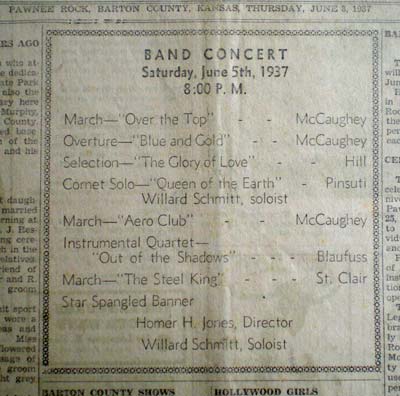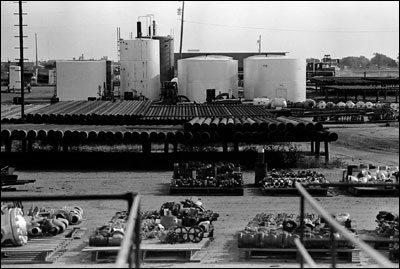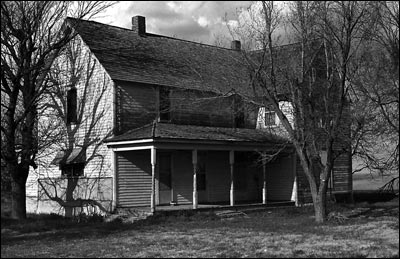
|
|
|
Search our site
Check these out    Do you have an entertaining or useful blog or personal website? If you'd like to see it listed here, send the URL to leon@pawneerock.org. AnnouncementsGive us your Pawnee Rock news, and we'll spread the word. |
Too Long in the WindWarning: The following contains opinions and ideas. Some memories may be accurate. -- Leon Unruh. Send comments to Leon November 2009Where we come from, what we are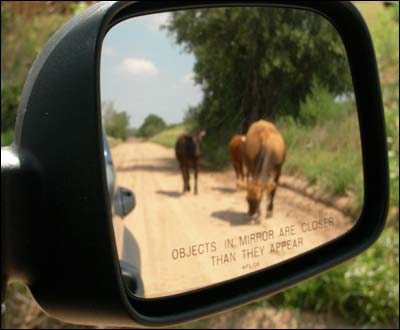
[November 30] In my linguistics class last week, we were discussing the responsibilities a person has to his or her culture. It had to do with my term paper, which looks at the indigenous Sami population (you grew up thinking of them as Lapps) spread throughout the countries of northern Scandinavia. Can a Sami man, I asked, maintain his "membership" in Sami society even if he assimilates by using an official Norwegian language and working in Norwegian society? By the same token, if a Kansan moves to Oklahoma or Texas, can he still be a Kansan? We discussed what is required for remaining in a culture. Do you have to stay where you're born? Do you have to celebrate all the holidays? Does your birth language have to remain your main language? "I still think of myself as a Kansan," I announced, "even though I haven't lived there for more than 20 years and my friends who stayed probably think I'm long gone and not nearly as Kansan as they are." I don't speak pure Kansan anymore. Eleven years working in Texas and seventeen in Alaska have given me an accent, although I still understand native Kansas speakers. On the plus side, I write about Kansas several days a week and think about it -- and not just about the Jayhawks -- each day. So, am I a Kansan? Did I give up my cultural membership when I traded in my Kansas driver's license? My professor picked up on something else. "I'm surprised you associate Kansas with Oklahoma and Texas," he said. "I would have thought you'd pick . . ." "Nebraska? The Dakotas?" ". . . and Iowa," he finished, mentioning his own home state. I don't say this to insult Nebraskans, but it seems to me that Kansas -- at least our part of Kansas -- has much stronger ties to the states south of the Sunflower State than to the north. The cattle trails ran up from Texas and Oklahoma, and the Cherokee Strip land run of 1889 was launched from Kansas. We have gas and oil, just as our southern neighbors do, and our south wind comes from those two states. We look to the south to see how the wheat harvest is progressing, and we forget about it once it passes Interstate 70. Part of Kansas used to be part of the Republic of Texas. The Santa Fe Trail connects us with the southwest, and Kansas' population growth isn't coming from Nebraska. When I look north from Pawnee Rock, my interest is blocked by I-70, which diverts my attention east to Kansas City and west to Denver, and if I look beyond I-70 I see practically nothing but Harold Warp's Pioneer Village. I say that even though Willa Cather, of southern Nebraska, is one of my favorite authors. Except for the territory-forming Kansas-Nebraska Act of 1854, these two states are barely linked by history. Alaska's society and geography are very important to me, as Texas' used to be, but Kansas still seems to be the basepoint of my mental atlas. So, who am I? Living on the plains may not be my way of life, but my young years there are central to my self-image. I've seen the bright lights of Dallas and the white nights of Alaska and I still call Pawnee Rock home. I'm going to say that makes me a Kansan living abroad. Barbara Wilson Ater dies[November 25] Barbara Wilson Ater, who was in the first class to graduate from the new Pawnee Rock High School building, died on November 21 in Ellinwood. She was 70 years old. Mrs. Ater was a member of the Christian Church in Pawnee Rock. Her funeral is this morning in Great Bend, and she will be buried in the Great Bend Cemetery. Mrs. Ater's survivors include son Allen D. Ater of Great Bend; daughters Jeanette Corbett of Ellinwood and Teresa Ater of Bunker Hill; and brothers Bill Wilson of Hays, Keith Wilson of Wichita, and Randy Wilson of Larned. She had nine grandchildren and six great-grandchildren. (Full obituary) A mouthful of horehound
[November 25] It had been 30 years -- since the last time I had Thanksgiving dinner at Grandma Unruh's table -- that I had eaten a piece of horehound candy. Three decades that ended this week. The candies were one of Grandma's favorites, and as a kid I couldn't tell why. They filled my mouth with the oddest flavor, kind of like a cough drop made from potpourri. Their name alone -- coming from "a bitter mint with downy leaves," according to Webster -- was enough for this Mennonite kid not to ask for them by name. A few months ago I came across a bin of bags of horehound candy at Wal-Mart, so I took home a bag emblazoned: "Horehound. Old Fashioned Hard Candy. Soothing to the Throat." I didn't get around to tasting them, and finally it became Thanksgiving week and I decided I'd better get on the stick. So I asked son Nik to sample one. I hoped he would say something that would prompt memories from my own childhood. When I put a candy in his hand, he sniffed it and pulled the trash can over. "Just in case," he said. Nik watched to make sure I wasn't tricking him; he didn't try his horehound until I popped mine in. He first tasted the coating of powdered sugar. "It's sweet," he said. Then he sensed the herb that packs the punch behind the sugar and corn syrup. "It tastes like something that went bad," he said. "It's milder than I remember," I said. "I thought they would be a much more aggressive flavor. Of course, maybe they used to make them stronger." "It tastes like an antique shop," he said. "Do you know what potpourri is?" I asked. As for myself, I had remembered a louder sensation. The horehound was no longer a mouthful. Yesterday, I offered the candy to three friends from work. They puzzled over it. "Does it taste like root beer?" I asked. "Yes," one said. Then, "No. It tastes like molasses candy." Well, there you have it. Horehound tastes like antiques and molasses. Sweet old memories. Happy Thanksgiving, everyone. John Foster, the big Lion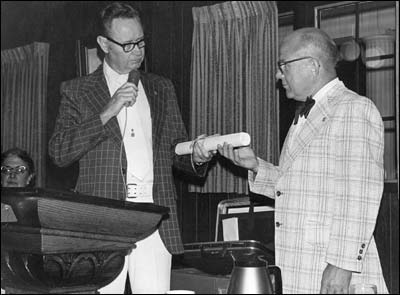
John Foster makes a presentation at a Lions Club event at the Harvest Inn in Larned in 1974 or 1975. [November 23] When I consider the Lions of the past, I miss John Foster the most. He was flashy. A big talker. Friends in many places outside our windy town. He was always proud to announce that he was from the "high-rent district" in beautiful Pawnee Rock, and as a district president of the Lions, he got to mention that in plenty of towns around the state. The 1970s were a time of plaid sports jackets, and John had a dandy collection. I photographed him wearing a number of them at various Lions Club events. I also associate him with the imitation Lifesavers that the Lions Club sold to raise money. He and his wife lived in the present Trotnic home on Cunnife Avenue. New family in town[November 23] Sheryl Spears wrote this past weekend with news: "We are buying a home in Pawnee Rock and I am very excited about becoming a part of the community. I have a handyman business with my husband and we look forward to helping the city of Pawnee Rock and its people." Good luck to Sheryl and her husband's business, and I wish them a long, happy stay in Pawnee Rock. Pawnee Rocker on ice
[November 23] Growing up where you and I did, we didn't have a lot of experience with natural bodies of water, and even less knowledge of ice. If we trusted the ice atop a pond or the river, we were as likely to fall through as we were to make it to the other side.
Part of my understanding -- or lack thereof -- of frozen water must come from the story Virginia Fry read to us in fourth grade about Hans Brinker, the Dutch skater who flew like the wind over canals that cracked behind him. Even though I now live far from Pawnee Rock's relatively mild but windy winters, I haven't gotten over my mistrust of ice-covered water. I see people drive trucks onto the ice here and I know it's two or three feet thick, but I am certain there's a thin spot that will one day take advantage of my errant footstep and pull me into the pond's liquid center. My sons, however, don't have that fear by late November. They'll walk out on a pond like it's a trip to the post office. That's why I let them go first when we hike. They have a world to explore, and I'm still trying to come to grips with the one I came from. It's summer somewhere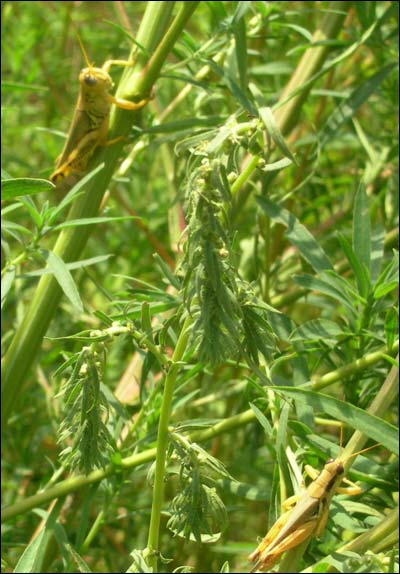
Grasshoppers in the greenery in the Arkansas River bed south of Pawnee Rock. [November 20] It's a cold week where I live now, and it's going to get much colder this weekend. We haven't seen the sunny side of 32 degrees for weeks. Today we have 5 hours 50 minutes of sunlight, and there will be six minutes less than that tomorrow. My cabin's thermostat is set at 54 degrees. My fingers are cold. Thank goodness I can still whine. I need some summer, so I flipped through my files in search of the essence of August. Maybe it's not very cold where you live, but perhaps you'd share the moment with me. Come on. Let's walk through the weeds and grab a grasshopper. For lunch, we'll have a peanut butter-and-cucumber sandwich. In the evening, we'll sit on the porch and listen to the Royals game. Thank you for coming along. We now return you to your regularly scheduled climate. Music for downtown Pawnee Rock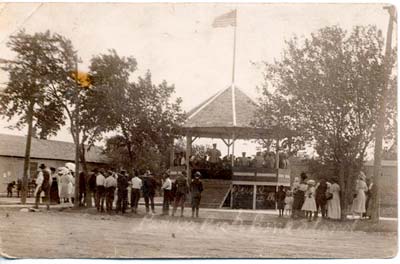
[November 19] Some Pawnee Rockers may remember music concerts held downtown during the summer early in the 20th century. One gazebo stood at the intersection of Centre and Pawnee, and another may have been nearby before or after. The one in this photo appears to be on the corner where Elgie's Craft Shop once stood (before that, it was a garage and now it is used by Farmer's Grain to store equipment). That's the Clutter Lindas Lumber Co. behind it. In late May 1937, the concert season was about to begin. The program, accompanied by a brief story, was displayed on the top of the front page of the Pawnee Rock Herald:
Band Concerts Continue Through the SummerThe first open air band concert will be given Saturday evening, June 5, at the band shell. Homer H. Jones, music supervisor in the schools, will be in Pawnee Rock this summer and will direct the band, hold regular practice periods, and have a public concert each Saturday evening. The songbird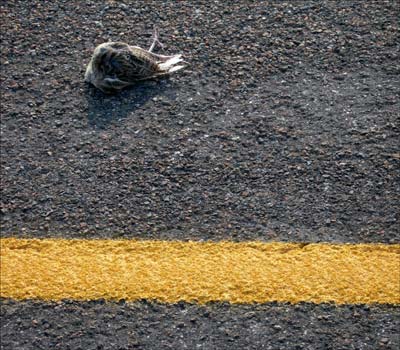
[November 17] The little bird never hurt anyone. It sang and it ate insects, and it sat on a fence and was pretty. And then one afternoon it got hungry and didn't pay attention to traffic. I like birds. I'm amused by possums and rabbits, too, but I don't mourn them when I come across a cottontail pancake. When I came across this lark on a road west of Pawnee Rock, I pulled over and took photos of it because of its juxtaposition against the cheerful brightness of the center line and the gritty asphalt. And then I started to think about the bird; more precisely, I started to feel. There wasn't anything special about this bird. In fact, I would come across one or two more avian casualties before dark. Still, I thought it deserved a better disposition than lying on the road would bring it. I slid my hand under the bird and carried it to the east-side ditch, where I laid it on a grassy bier. In retrospect, I suppose I was making a tribute to birds whose melodies had floated to me on the breezes of other summer evenings. If a meadowlark's trill isn't the voice of heaven on earth, I am at a loss to know what is. Sensational travel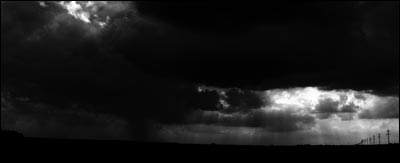
Stormy night sky in western Kansas. [November 17] Last Saturday after dark I drove north 350 miles to Fairbanks in snow and ice fog on a highway that was sometimes nothing but a white expanse delineated by small berms on the shoulders. The temperature hung around zero, and the wind in the mountains shimmied powder across the highway in my headlights. The road was almost empty of traffic. There was no scenery but the road. Birches and spruces blocked the view 30 feet from the road, except where there were no trees, and then the view was nothing but blackness. Even the usual hum of studded tires was hushed by the veneer of new and packed snow. It was the equivalent of driving from Pawnee Rock to Denver and passing only a half-dozen towns about the size of Pawnee Rock. No brightly lit gas plazas, no 18-wheelers, no screaming billboards. No fast food. At that hour, no food at all. My trip Saturday was an exercise in sensory deprivation. That's not like Kansas travel. Drive through rural Kansas at night and -- unless you're in a raging storm -- there's always the glow of a town in front of you or off to the side. There are farmhouses with a streetlight in the yard, car-repair shops, misplaced antique shops with a single light burning above the cash register. There is traffic: pickups shoving their headlights into your vision, cars with maybe-drunks behind the wheel, cattle loose from the pasture. Skunks. Think about your driving. If it's warm, you have the windows open. You smell the fields and hear the irrigation pumps. If it's chilly, the heater's on but you sense the rhythm of the repaired asphalt and, if you're like me, you crane your neck to stargaze through the windshield. Not far ahead of you on the highway, red lights blink from atop elevators and radio towers. Every 30 miles or so, a county seat's airport beacon revolves and you catch the green-white-green signal. The wind whispers past the car. The radio plays bad AM radio or canned FM or a basketball game. Kansas drivers are never at a loss for sensation. There's no gliding through life on the Sunflower State's two-lanes. There's no getting somewhere in the dark and not quite understanding how you got there. Albert: "It served the purpose"[November 16] Even though I had a checking account at the bank in Albert and took out my first loan there, the town of Albert had always been of small mind to me. It was a place I passed through on my way to Hays, at most. I know that's unfortunate, because our neighbor 11 road miles to the north probably had many interesting people. But you know how towns are. Kids from Albert often went to Otis-Bison schools, so we didn't have much to do with them. I came across this bit of information about Albert while browsing through the "Biographical History of Barton County, Kansas," published in 1912. Albert"It was back in the early 80s when C. B. Worden and other residents of his township realized the necessity for a town where they located Albert, which is on the Scott City branch of the Santa Fe railway, seventeen miles northwest of Great Bend. Albert, like other towns in that section of the county, never had a boom, but a short time after it was laid out it served the purpose for which it was intended and offered the people of that section of the county a trading point and it was not long until nearly all lines of retail business were represented. The first store was started by Charles Hayes who later sold out. Albert now has a bank, four elevators, hotel, livery and feed stable, two general merchandise stores and a population of about 170. It was near the townsite." Parrish or die[November 13] When I was a wee grade-schooler, I learned from listening to the preacher ("Those who believe in me shall not perish") a perfectly good synonym for "die." As my cognitive skills improved, I put two and two together every time we went to downtown Great Bend and figured out that the Parrish Hotel was where people went to die. It was such a profound discovery that I don't know whether I ever mentioned it to my parents. I was scared of the place. Well, now the highly accomplished woman who ran the place has indeed died. She was Betty Parrish, and she was 94 years old. She had married Clement "Monte" Parrish back before World War II, and when Major General Moore went off to war she ran the hotel and restaurant. You can read more about her in the obituary printed in the Great Bend Tribune. Neatly arranged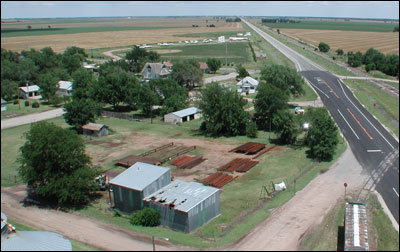
A yard east of the big elevator holds pipes waiting to be used. This photo was made in 2005.
A pipeyard along U.S. 56 held a lot of unused material during an oil bust around 1990. [November 12] I've never been one to keep a clean desk or clean car. My hair is a stocking-cap-created mess, and below that even my mind is a mess. People who can keep things in order have my admiration. Doubly so for the people who do it on a large scale . . . like pipe companies. Maybe it's easy for them. Nothing is placed casually when it has to be moved by forklift. If my wife is right, a forklift is just what I need to clean off my desk. A picture of the past[November 12] Larry Mix, the operator of the Santa Fe Trail Research Site, sent this: "Found this and thought you might like it. The road that ain't there any more." Veterans Day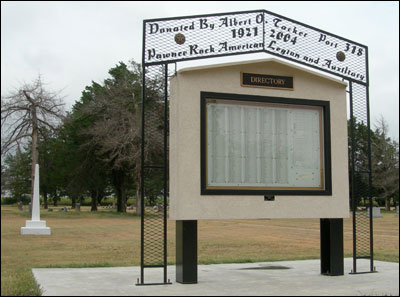
The American Legion's legacy at the Pawnee Rock Township cemetery. [November 11] Today is Veterans Day, when we thank those who have served in the military. We remember those who died in that service or who came back and are living, we hope, long and rewarding lives. Pawnee Rock has sons who have fought in the current round of wars, and we have a long history of being associated with the military. The eastern slope of Pawnee Rock State Park has a cenotaph dedicated to a U.S. soldier traveling the Santa Fe Trail in the 1840s to fight the Mexicans, and of course the whole area around the Rock was a battlefield in the long military and commercial war against the Indians. The soil of our township cemetery holds the remains of soldiers who helped keep the peace or who fought in the Civil War, the Spanish-American War, World War I, World War II, the Korean War, and the Vietnam War. Let us remember, regardless of our politics and beliefs, that the United States has an all-volunteer military now, and every man and woman in uniform has willingly acknowledged the risk of sacrifice and death. Individually, they may not know you and they may not like you, but they would kill and die in your name because you are an American. Today and next week and next month, thank a veteran. The barns of our lives[November 10] Gary Blackwell sent a cheerful note yesterday: "As always I have been enjoying all of your writings and the old & new Pawnee Rock news. Love to hear what you and the boys have been doing, the Unruh barn was great! My son and daughter love to tell about all the things they did at Thanksgiving in their Uncle's big barn!" Let's hear it for kids and barns . . . and for family Thanksgivings. The west end of the gym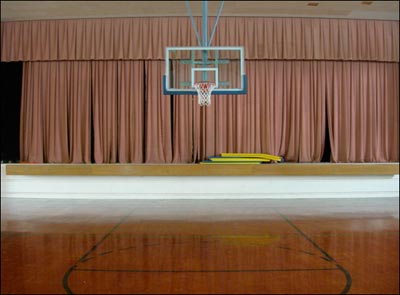
[November 10] A few personal memories of this end of the Pawnee Rock gym: • Queens were crowned here and ruled from this stage over the homecoming basketball games. Like every other young boy in town, I would have been happy to stand next to the queen or any of her court. • The Braves were playing some team. "T-Bone!" another player shouted. (Was that Mark Dirks?) • Blond-haired Jake Crosby bounced a basketball off an opposing player's head after the whistle blew. And then he grinned crookedly at the guy. Maybe it was an accident. • In junior high, Bob Hemken was preparing for the opening tip against Hanston. I nodded my head to the left, and he tipped the ball toward this basket. I caught it on the run and made a left-handed layup. It was the first time I ever scored the first two points in a game. • In a high school B-team tournament game in March 1972, Virgil Ritchie blocked an inbounds pass right into my hands and I made a layup in this basket. And then over the next few minutes I made six out of six free throws in this basket. My own personal cheering section -- Rob Bowman and Ray Tutak -- sat on the stage and chanted "Let's go, Leo," for each free throw and it was the only time I ever led a team in scoring. • Although pep rallies and most school assemblies were convened at the other end of the gym, our last athletics assembly -- when school letters were handed out -- occurred at this end. Coach Gary Romeiser handed out each letter -- thick yellow Berber carpet stitched onto a felt "P." • School plays were performed here. The Blue Notes band lined up behind their wooden music stands and gave us jazz and swing. • The Lions Club raised money in 1974 by presenting a magic show on this stage, and this end of the gym was filled with students, parents, preachers, and a bunch of church-going people I previously thought had no sense of humor.
Meat for the table
[November 9] A friend from work and I were talking last week about how much moose and caibou her family would have in their freezer after this year's hunting season, and as she described the division of meat my mind wandered off to yesteryear. Our family in Pawnee Rock was not a hunting family, so we didn't sit in trees and shoot arrows or bullets at deer. Thus, I never knew the business side of carting off a carcass to a butcher shop to be turned into venison steaks and sausage. But I did understand the process of how we filled our freezer. Someone took a cow from Grandpa and Grandma's farm over to Leon Rankin's butcher shop on the east side of Larned, and a few days later we carried out steaks, roasts, and ground beef wrapped in slick white butcher paper closed up with tape. I can't say for sure, but I think the big stand-alone freezer we had in our basement was acquired just for those quarters of beef. It wasn't until I reached high school and read "The Jungle" by Upton Sinclair that I learned how cows go to heaven via the butcher shop. I asked about the process once at Rankin's, but Mr. Rankin didn't want to show me. He said there weren't any cattle in the pen at the moment, or some such, but he also didn't invite me to come back later and I think he was just practicing community relations by not instigating nightmares. It was probably a good thing for me at the time; once you see and hear it, you can't unlearn the details of slaughter. And for a guy who really didn't need to know the details, that was fine. To this day, I was and am happy eating beef. Had I been raised on a farm or kept a cow or lamb that would be sold at the 4-H fair, I would certainly have had a more informed opinion about the food chain. I might have spent a few nights crying into my pillow after I no longer heard that special moo or baa, but I might have been practical about it.
Anyway, there was other blood. Grandma occasionally walked back from the chickenhouse with a hen tucked under her arm, and she'd snap its neck and cut its head off to give us city cousins a look at real life. She smiled as we watched, mouths flapping nervously, while she performed the deed in the yard off the big porch. That was just to feed the three or four of us kids. A real family meal, as she fixed when her husband was alive and they had four teenagers at home on the working farm, would have required a couple of chickens. Over a year, there would be a lot of feathers, feet, and loose heads to be disposed of. I marvel sometimes at how removed I was from the bloody facts of providing food, when just 30 years earlier my dad's family was killing chickens in the yard and cutting up hogs on the dining room table. I have that table now in my own home; when I mention its history once a year the boys respond with "Cool!" but they have never even seen a photo of a hog hanging to bleed out. My question as a parent is how deeply to introduce the boys to the production of food, to that point when mammals and birds move from living animal to menu item. How much more or less will they be happy at the table after they've heard the silence of the lambs? Evidence of the farm life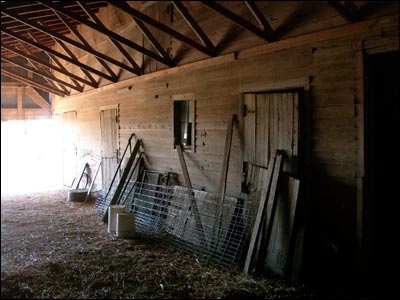
[November 6] This is an interior wall of what used to be my Unruh grandparents' barn and my great-grandparents' before them. Most of the time a combine or tractor was parked in front of the wall, so we kids rarely got the whole view that was visible on my last visit. I would have been happy living in the barn. It was as big as a gymnasium, and it even had a basketball hoop -- a barrel hoop -- nailed to a side room in the hayloft. The barn held heavy steel tools, and old ropes, and piles of hay way past its sell-by date. It had mangers and dusty rooms that were perfect for kids playing hide-and-go-seek, as kids had since the barn was built around 1900. The loft had pigeons and the skeleton of a cat, evidence of the pack of feral felines we sometimes glimpsed. Grandma suspected that there were rats, and so there also was poison. This was where our family's business was carried on, at least through my dad's generation. None of us cousins wanted to work that way, and eventually the farm was sold to pay Grandma's way through the nursing home in Great Bend. Memories, however, stayed in the family. The barn now is a stick-and-tin monument to a way of thinking supplanted by Butler buildings and their steel-and-concrete siblings. I don't know when I'll next have a chance to slip into the barn, but I must take my boys. It's the most visible emblem of the life our family kept for generations, and until they spend an hour in the barn the boys will never really understand their own dad. More wonders of Kansas?[November 5] Having found a formula that keeps its name and Kansas' geography in the newspapers, the Kansas Sampler tourism site is launching another 8 Wonders of Kansas contest. Clara Kilbourn's story in this morning's Hutch News describes the effort and suggests a few places that might be nominated this month. Maybe this will be the year that Pawnee Rock -- or maybe our Arkanas River -- is nominated. The Kansas Sampler organization does a lot of neat things to encourage Kansans and the less fortunate to enjoy the Sunflower State. Find out more at KansasSampler.org. Weather facts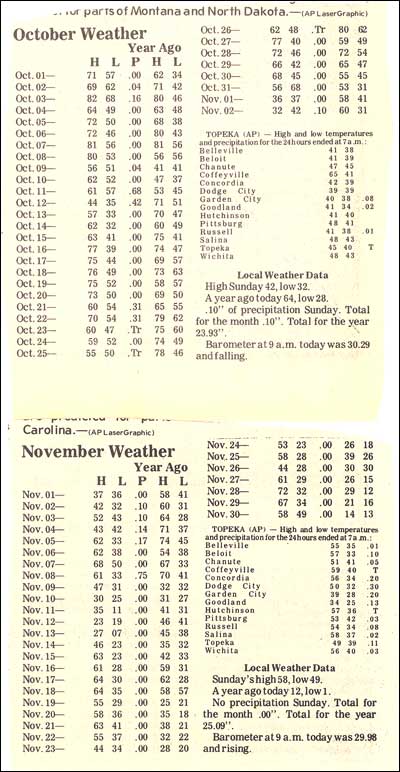
[November 4] My dad, Elgie Unruh, clipped and saved a lot of newspaper clippings, including monthly temperature reports for posts around Kansas. Nowadays all this info is available online, and its easy accessibility sometimes leads me to forget the thrill I used to have when I came across these tables. Strictly speaking, the information didn't have much value, but it was -- as is still -- fun to discern patterns and try to remember days because of their remarkable warmth or chill or sameness. The charts above are from late 1986 and came from the Great Bend Tribune. The temperatures were recorded to the airport. Find the address[November 4] John Parsons wrote asking about where to find Jack Bowman (Gene Bowman's son). Roger Hanhardt, another Pawnee Rock alumnus, suggests looking for Jack in Ellinwood by using a service such as anywho.com. Push-button success[November 3] Remember your first trip to a Sonic drive-in? Or maybe you have your fondest memories of the A&W drive-in on North Broadway in Larned. The guy you can thank for that pleasure -- reading the menu, pushing a button, and ordering a meal from your car seat while you hang around town for the Thursday afternoon city-wide drawing, or parking in public with a sweetie on date night -- is Troy Smith. He was an Oklahoman who got rich by figuring out how Americans wanted to eat. Smith died a week ago and has been written up in The New York Times. If I still lived in Sonic country, I'd go out today and order a Sonic Burger, Tater Tots and a big cherry limeade. Seeking Jack Bowman[November 3] John Olson of Parsons has written in search of information of Jack Bowman, who last month was named to the Great Bend High School Hall of Fame. "Jack was my coach at Riley County during the 1959-60 school year. Was wondering if you might have an address for him or have any suggestions about how I might get in contact with him. Any help you might give would be appreciated," he wrote. Does anyone know how to reach Jack Bowman? Larry Mix and Stafford County photos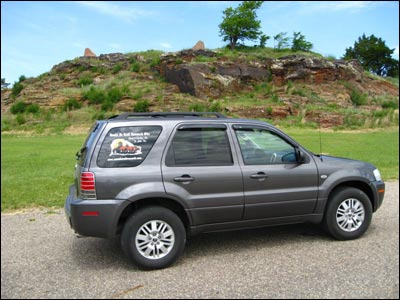
[November 2] Larry Mix, who runs the Santa Fe Trail Research Site and who has sent us quite a few Pawnee Rock photos, was back in town recently. If you see this fine set of wheels, which are based in St. John, stop and give Larry a big hello. As you can see from his site, he's dedicated to local history. Larry reminds us that the Stafford County Museum is scanning many photographs and putting them on the Internet -- and Larry has seen some Pawnee Rock shots among them. "Maybe somebody from the Rock can find a photo of some long lost family members," he wrote. Larry also suggests taking a look upward for the International Space Station. |
Sell itAdvertise here to an audience that's already interested in Pawnee Rock: Or tell someone happy birthday. Advertise on PawneeRock.org. |
|
|
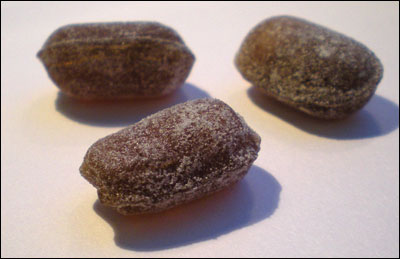
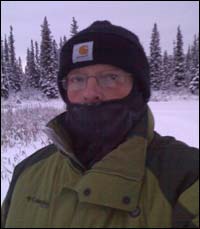 Now, I know that our ice was thick enough sometimes for folks to skate on. We've had photos on this site of the family of Virgil and Joan Smith skating on a backwater near the Pawnee Rock Bridge.
Now, I know that our ice was thick enough sometimes for folks to skate on. We've had photos on this site of the family of Virgil and Joan Smith skating on a backwater near the Pawnee Rock Bridge.